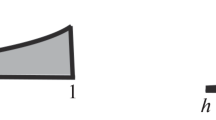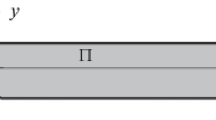Abstract
The effect of a “black hole” for elastic waves, discovered by M.A. Mironov and examined in detail by followers, is usually associated with propagation of elastic waves along the cuspidal sharpening of a deformable solid, i.e., the cusp absorbs the energy of elastic oscillations and does not return it to a massive part of a body. At the same time, an ideal cusp cannot be made and its tip is blunted in real constructions. Smoothing of the sharpening crucially changes the spectrum structure: the continuous component disappears, but the concentration of eigenfrequencies in the mid-frequency range occurs. This note provides asymptotic formulas for eigenvalues of the Kirchhoff beam with a thinning end and on their basis describes a new and effectual mechanism of action of the “black hole,” namely, a blunted cusp, in which propagation of waves becomes impossible, but trapping of waves occurs at “almost all frequencies” within a wide enough spectral range. Improvement of the cusp’s quality leads to enhancemen of the concentration of eigenvalues and enlarging of its region of occurrence.


Similar content being viewed by others
REFERENCES
M. A. Mironov, Sov. Phys. Acoust. 34, 318 (1988).
V. V. Krylov, Acta Acust. Acust. 90, 830 (2004).
V. V. Krylov and F. J. B. S. Tilman, J. Sound Vibr. 274, 605 (2004).
M. A. Mironov, Acoust. Phys. 63, 1 (2017).
A. Pelat, F. Gautier, S. Conlon, and F. Semperlotti, J. Sound Vibr. 476, 115316 (2020).
S. A. Nazarov, Sib. Math. J. 49, 874 (2008).
V. Kozlov and S. A. Nazarov, Adv. Differ. Equat. 21, 887 (2016).
V. A. Kozlov and S. A. Nazarov, J. Elasticity 132, 103 (2018).
S. A. Nazarov, Dokl. Phys. 62, 512 (2017).
S. A. Nazarov, Mech. Solids 54, 694 (2019).
S. A. Nazarov, Sb.: Math. 210, 1633 (2019).
S. G. Mikhlin, Variational Methods in Mathematical Physics (Nauka, Moscow, 1970) [in Russian].
M. Sh. Birman and M. Z. Solomyak, Spectral Theory of Self-Adjoint Operators in Hilbert Space (Leningr. Univ., Leningrad, 1980) [in Russian].
Funding
This study was supported by the Russian Science Foundation, project no. 17-11-01003.
Author information
Authors and Affiliations
Corresponding author
Additional information
Translated by N. Podymova
Rights and permissions
About this article
Cite this article
Nazarov, S.A. The Essence of “Black Holes” for Elastic Waves in Solids with Cuspidal Sharpening. Dokl. Phys. 66, 182–185 (2021). https://doi.org/10.1134/S1028335821060069
Received:
Revised:
Accepted:
Published:
Issue Date:
DOI: https://doi.org/10.1134/S1028335821060069




